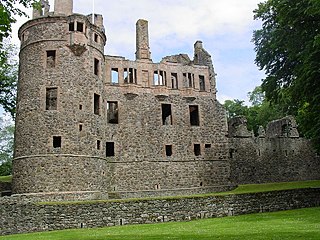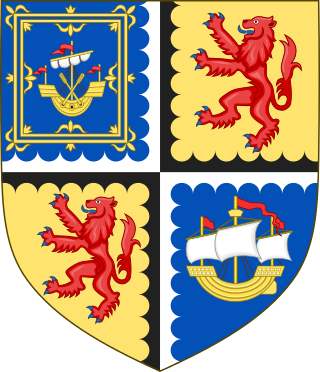| |||||
| Centuries: | |||||
|---|---|---|---|---|---|
| Decades: | |||||
| See also: | List of years in Scotland Timeline of Scottish history 1590 in: England • Elsewhere | ||||
Events from the year 1590 in the Kingdom of Scotland .
| |||||
| Centuries: | |||||
|---|---|---|---|---|---|
| Decades: | |||||
| See also: | List of years in Scotland Timeline of Scottish history 1590 in: England • Elsewhere | ||||
Events from the year 1590 in the Kingdom of Scotland .

Huntly Castle is a ruined castle north of Huntly in Aberdeenshire, Scotland, where the rivers Deveron and Bogie meet. It was the ancestral home of the chief of Clan Gordon, Earl of Huntly. There have been four castles built on the site that have been referred to as Huntly Castle, Strathbogie Castle or Peel of Strathbogie.

Clan Mackay is an ancient and once-powerful Highland Scottish clan from the far North of the Scottish Highlands, but with roots in the old Kingdom of Moray.

Clan Gunn is a Highland Scottish clan associated with lands in northeastern Scotland, including Caithness, Sutherland and, arguably, the Orkney Isles. Clan Gunn is one of the oldest Scottish Clans, being descended from the Norse Jarls of Orkney and the Pictish Mormaers of Caithness.

Clan Sutherland also known as House of Sutherland is a Highland Scottish clan whose traditional territory is the shire of Sutherland in the far north of Scotland. The chief of the clan was also the powerful Earl of Sutherland; however, in the early 16th century, this title passed through marriage to a younger son of the chief of Clan Gordon. The current chief is Alistair Sutherland, who holds the title Earl of Sutherland.

Clan Sinclair is a Highland Scottish clan which holds the lands of Caithness, the Orkney Islands, and the Lothians. The chiefs of the clan were the Barons of Roslin and later the Earls of Orkney and Earls of Caithness.
Donald Mackay, 1st Lord Reay, 14th of Strathnaver was a Scottish soldier and member of Parliament. He played a prominent role in the Thirty Years' War, raising a regiment of 3,000 men, which served in both the Danish and Swedish forces. He was later an unwilling Covenanter. He was the fourteenth chief of Clan Mackay, a Highland Scottish clan.
The Battle of Torran Dubh also known as the Battle of Torran-dow or the Battle of Torran Du was a Scottish clan battle that was fought in 1517 in Sutherland, in the Scottish Highlands.

Pulrossie is a farm in Sutherland, in the Highland council area of Scotland. It is situated on the northern shore of the Kyle of Sutherland, 8 km west of Dornoch. Skibo Castle is 1.5 km to the north-east, while Meikle Ferry is 1.5 km south-east.

John Sinclair was a Scottish nobleman, 3rd Earl of Caithness and chief of the Clan Sinclair, a Scottish clan of the Scottish Highlands.
Huistean Du Mackay, 13th of Strathnaver, was the thirteenth chief of Clan Mackay, a Highland Scottish clan.

The Battle of Clynetradwell was a Scottish clan battle that took place in 1590 in the county of Sutherland between the forces of Alexander Gordon, 12th Earl of Sutherland and George Sinclair, 5th Earl of Caithness.
John Gordon, 11th Earl of Sutherland (1525–1567) was a Scottish magnate. John Gordon supported the chief of his family, his cousin the Earl of Huntly against the Earl of Moray. After Huntly's defeat at Corrichie, he went into exile, and shortly after his return to Scotland he was murdered by a kinswoman.
The Murrays of Aberscross were a minor noble Scottish family who were seated at Aberscross Castle, in the county of Sutherland, Scotland. The Murrays in Sutherland are recorded specifically as a clan in two acts of the Scottish Parliament of the 16th century.
Iye Du Mackay, 12th of Strathnaver, was the chief of the Clan Mackay, a Highland Scottish clan, from 1550 to 1572.
The Sutherlands of Kilphedder (Killipheder) were a minor noble Scottish family and a branch of the ancient Clan Sutherland, a Highland Scottish clan. They were seated at Killipheder, in the county of Sutherland, Scotland.
Donald Mackay, 11th of Strathnaver, was the eleventh chief of the ancient Clan Mackay, a Scottish clan of the Scottish Highlands.

The Battle of Torran-Roy was a Scottish clan battle that took place in the year 1570 in the county of Sutherland, Scotland. It was fought between the forces of Alexander Gordon, 12th Earl of Sutherland and the forces of George Sinclair, 4th Earl of Caithness. The Earl of Sutherland's force consisted primarily of the Murrays of Aberscross who despite their name were not part of the Clan Murray in Atholl, but who were a sept of the Clan Sutherland, and who as the principal vassals of the Earl of Sutherland, were charged with the defense of the shire. The Earl of Caithness's forces consisted primarily of followers of Alexander Sutherland, 8th of Duffus who was a descendant of the old Sutherland Earls of Sutherland who had been ousted and replaced by the Gordons as earls in the early 16th-century.

George Sinclair was a Scottish nobleman, the 4th Earl of Caithness and chief of the Clan Sinclair, a Scottish clan of the Scottish Highlands.

George Sinclair was a Scottish nobleman, the 5th Earl of Caithness and chief of the Clan Sinclair, a Scottish clan based in northern Scotland.
Alexander Gordon, 12th Earl of Sutherland was a Scottish landowner.